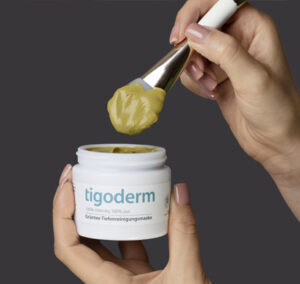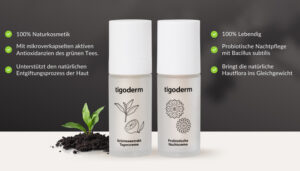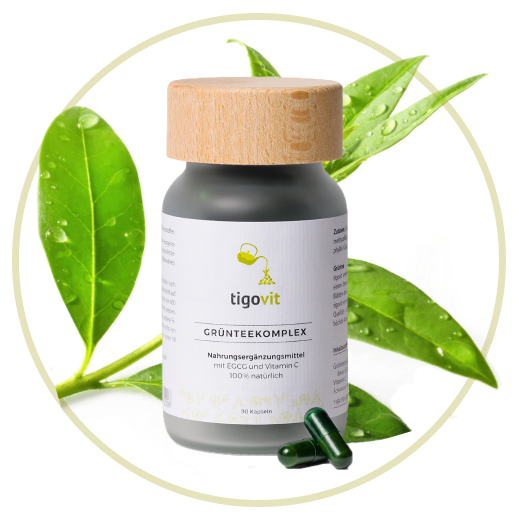Important update: Green tea as a food supplement is once again being targeted by European safety authorities, which naturally leads to uncertainty on the part of consumers. Green tea is said to be a burden on the liver, which is why it is better to keep your hands off the superfood that used to be so hyped. What is the truth behind these accusations? Can the intake of tigovit green tea capsules Leber damage? The answer: If taken according to the instructions on the pack, there is no risk. Learn more details in this article.
The innovations in brief: The daily intake of EGCG under 800 mg must not be exceeded according to the EFSA. EGCG from green tea extract should not be taken in case of liver or kidney diseases and is unsuitable for pregnant women, nursing mothers and adolescents under 18 years of age.
Important: EGCG content is not the same as green tea extract content. The tigovit green tea complex contains 300 mg of green tea extract per capsule, of which only 170 mg is EGCG (epigallocatechin gallate, the main representative of green tea catechins). With a recommended dosage of two to three capsules daily, you consume 600-900 mg of green tea extract, thereof 340-510 mg EGCG per day. The daily intake of tigovit can be increased to a maximum of 3 capsules per day, for example for a short-term cure.
For a long time, green tea has been considered a Wellness drinkwhich is loved by many magazines and stars. However, any drink can have the opposite effect if overdosed or if the quality of the ingredients is poor. Namely, it can develop side effects and cause harm.
EFSA gives recommendation for green tea consumption
Therefore, the European Food Safety Authority (EFSA) on whether overdosing on green tea supplements can prove harmful to the liver. The research findings came during World Liver Day 2018. As you might expect, the news has green tea fans in a tizzy. But don't worry: you don't have to give up green tea altogether.
The good news first. You don't have to have your beloved green tea bad-mouthed. According to EFSA, it all depends on the dosage. While green teas contain 90 to 300 mg Catechins contain up to 1000 mg, dietary supplements contain up to 1000 mg. Researchers linked the intake of over 800 mg of catechins to liver damage. So don't worry when taking tigovit green tea complex - each capsule contains 170 mg EGCG, so with the maximum recommendation of 3 capsules daily, you are well below the limit of 800 mg EGCG, which is potentially harmful to the liver, with 510 mg.
But what exactly are catechins?
- Catechins are connections that lead to the Polyphenolsa subgroup of the secondary plant compounds.
- They are found in most types of fruit.
- Many plants synthesise catechins, including grapes, blueberries, legumes, parsley and many more.
- The highest content of catechins is found in green tea!
Accordingly, catechins are substances that are naturally present in green tea. The most common is epigallocatechin gallate (EGCG). In its safety assessment, EFSA investigated possible associations between the intake of EGCG from green tea infusions or food supplements and liver damage.
Facts about the liver & liver damage!
But before we look in detail at the news surrounding liver damage from green tea, here's a look at the organ it's all about: the human liver!
The Liver is the largest organ in the body. It is located below the diaphragm in the right upper quadrant of the abdominal cavity. The liver of an adult weighs about 3 pounds and extends approximately from the right 5th rib to the lower edge of the rib cage.
What is the purpose of the liver?
The main functions of the liver lie in the Metabolic processes of the body. These include:
- Degradation or conversion of substances
- Gain energy
- Make toxins less harmful to the body
- Remove toxins from the bloodstream
The liver does this by receiving blood with nutrients from the digestive organs through a vein called the portal vein.
The many cells of the liver, called hepatocytes, absorb and filter this blood. They act as small sorting centres that determine:
- Which nutrients to process
- What is to be saved
- Excretions that occur via the stool
- What should go back to the blood
The liver stores vitamins as well as minerals such as copper and iron and releases them when the body needs them. It helps break down fats in a person's food. It also stores them or releases them as energy.
It also produces an estimated 800 to 1,000 millilitres of bile per day. This bile is transported to the small intestine via a bile duct. The small intestine uses the bile to further break down fats. The excess bile is stored in the gallbladder.
Other functions of the liver
The liver also breaks down proteins. A by-product of this process is ammonia, which can be toxic to the body in large quantities. The organ converts the toxic ammonia into a substance called urea. The liver releases this into the blood, where the kidneys excrete it through the urine.
The liver also breaks down the alcohol in the blood, as well as many medicines you take.
As if these functions were not enough, the liver also plays an important role in the following:
- In creating factors that can fight infections.
- Creation of proteins that are responsible for blood clotting.
- Degradation of old and damaged red blood cells.
- Storage of additional blood sugar as glycogen.
When you consider these factors, it is easy to see how important the liver is to a person's health.
EFSA recommendations for liver damage at a glance:
Infusions with green tea:
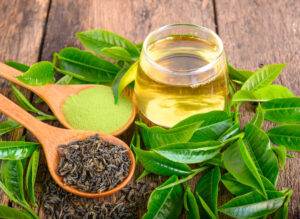
For green tea infusions, EFSA concluded that in general, even after high consumption, there is no evidence of liver damage. The individual cases of liver damage were probably due to rare reactions. Therefore, the experts classified catechins from green tea infused with hot water, as well as from instant and ready-to-drink Green tea drinks with similar catechin content as generally safe.
Food supplement with green tea
For food supplements, EFSA's experts found that EGCG doses of 800 mg/day may be associated with early signs of liver damage from green tea. A recent study reports in particular on people who are particularly susceptible to liver damage due to mutations in liver enzymes. Here, too, however, we are talking about intake in the high-dose range above 800 mg/day.
Even though there was no evidence of liver damage below 800 mg/day for green tea-based supplements, the experts could not determine a safe dose based on the available data.
tigovit green tea capsules & liver damage: What is important to know!
In this section we explain how you can take the tigovit green tea supplement without hesitation.
3 factors that are important for the best possible intake of green tea supplements:
Point 1: Quality matters
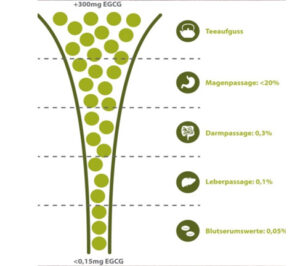
It's different at tigovit! We know how cultivation works for the Green tea plants for tigovit. First the cultivation area: It is located near the Yellow Mountains, which belong to the most famous and beautiful mountain regions in China. Because of the very good climatic and environmental conditions, the green tea plants from this mountain region are said to have higher quality polyphenols than those from other growing areas.
Pesticide-free cultivation for the green tea in tigovit
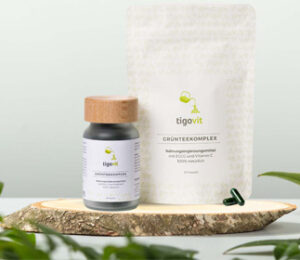
For more than 20 years, our Chinese partner Mr. Chang has been growing green tea on this tea plantation, which is also certified organic according to German standards. This guarantees a soil that has hardly come into contact with pollutants for two decades, has many nutrients and where the plants can grow without exhaust fumes or other environmental pollution.
This really pure and high quality, tested several times in laboratories, comes in the capsules from tigovit, which are what they promise: naturally pure, tested and with the best possible ingredients!
Point 2: Production with water is important!
Did you know? There is no uniform worldwide manufacturing process for herbal extracts. This means that green tea capsules produced in the USA or other non-European countries may have a different quality than products from the EU. Extracts intended for the D-A-CH countries (Germany, Austria, Switzerland) must be extracted with water only.
In recent years, however, herbal supplements containing green tea have been withdrawn from the US market. The reason? Liver poisoning! It is exciting that exactly these products were produced with 80 % ethanol as an extraction agent and were standardised to 25% of the green tea extract EGCG. Procedures and values that are not permitted in the EU!
Point 3: Do not take more than recommended!
As already written: The European Food Safety Authority (EFSA) found that 800 mg/day of EGCG may be associated with initial signs of liver damage from green tea. One capsule of tigovit has 170 mg of pure EGCG. The recommended daily dosage is a maximum of 3 capsules, which is only 510 mg. With 3 tigovit capsules a day, you are thus well below 800 mg and thus within the range recommended by the EFSA for the intake of green tea.
Sources:
https://www.food-safety.com/articles/8187-due-to-risk-of-liver-damage-eu-limits-green-tea-extract-with-egcg-in-foods
https://www.efsa.europa.eu/de/efsajournal/pub/5239
https://www.efsa.europa.eu/de/press/news/180418
https://www.hopkinsmedicine.org/health/conditions-and-diseases/liver-anatomy-and-functions
Photo by Andrea Piacquadio from Pexels
Pic by Simplyvegan.org

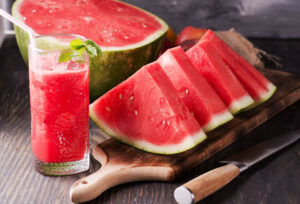 These foods are extremely rich in beta-carotene and also have a positive antioxidant effect on the body. Beta-carotene is a provitamin that can be supplied to the body as a food supplement in the form of tablets. In the body, it is converted into vitamin A, which protects the epithelium of the skin and mucous membranes.
These foods are extremely rich in beta-carotene and also have a positive antioxidant effect on the body. Beta-carotene is a provitamin that can be supplied to the body as a food supplement in the form of tablets. In the body, it is converted into vitamin A, which protects the epithelium of the skin and mucous membranes.
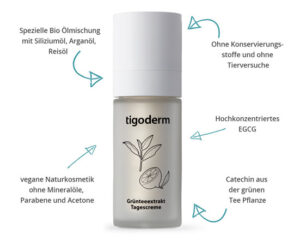
 This does not mean a professional massage in a spa, but a massage you can do yourself at home. Take a bottle of vegetable oil (olive or almond oil) and massage the whole body and face well. This treatment causes a better metabolism and blood circulation and the elimination of toxins. To do this, the massage reduces muscle tension, stress in muscles, skin and tissues, while reducing the production of the stress hormone cortisol in the body, which leads to relaxation and balance of the body.
This does not mean a professional massage in a spa, but a massage you can do yourself at home. Take a bottle of vegetable oil (olive or almond oil) and massage the whole body and face well. This treatment causes a better metabolism and blood circulation and the elimination of toxins. To do this, the massage reduces muscle tension, stress in muscles, skin and tissues, while reducing the production of the stress hormone cortisol in the body, which leads to relaxation and balance of the body. For a study, researchers from the National Yang-Ming University in Taiwan selected 80 women between 25 and 45 with moderate to severe acne. Half of the women drank a decaffeinated green tea extract equivalent to one cup a day for four weeks. The other half received a placebo.
For a study, researchers from the National Yang-Ming University in Taiwan selected 80 women between 25 and 45 with moderate to severe acne. Half of the women drank a decaffeinated green tea extract equivalent to one cup a day for four weeks. The other half received a placebo.